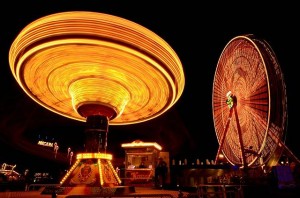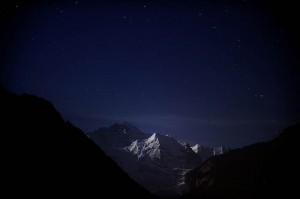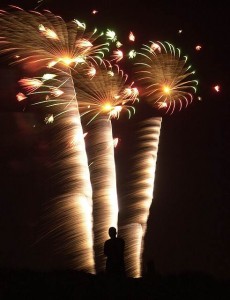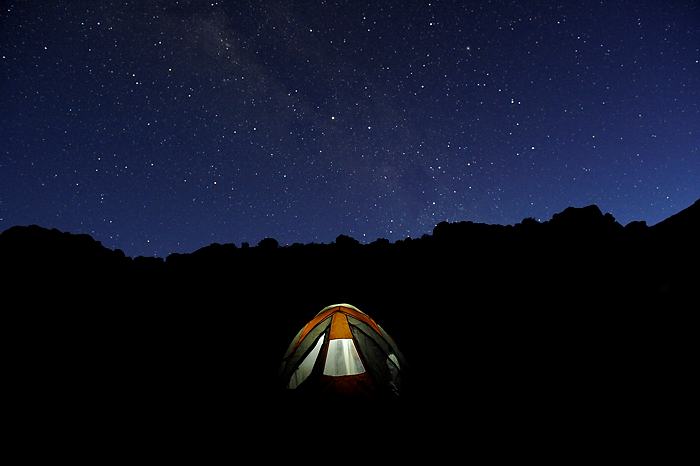I received an email from a friend who’s headed to Iceland and hoping to photograph the northern lights (aka the aurora borealis). He was looking for tips on how to be successful, and after responding to him, I thought this might make for a nice blog post. Whether you’re shooting northern lights, a starry sky or New Year’s eve fireworks, the basics are the same.
Any time you’re trying to photograph at night, in what we jokingly refer to as “available dark,” there are a few things to keep in mind.
First, the camera will need to be rock-solid, so I always suggest a good tripod. If you don’t have a tripod, find something you can set the camera on so you’re not holding it. Night exposures generally require the shutter to be  open several seconds or longer, which rules out hand-holding the camera.
Then you need a way to trip the shutter without moving the camera. Best is an electronic cable release, but if you don’t have one, you can often get away with using the camera’s self-timer. With it turned on, you can step away from the camera and let it trip the shutter at the end of ten seconds (or whatever time you have it set for). Most cameras today will let you set them for up to a thirty-second exposure. If you need to go beyond that, then you’ll need a locking release and want to use the “Bulb” setting. With “Bulb” set, the shutter will stay
open several seconds or longer, which rules out hand-holding the camera.
Then you need a way to trip the shutter without moving the camera. Best is an electronic cable release, but if you don’t have one, you can often get away with using the camera’s self-timer. With it turned on, you can step away from the camera and let it trip the shutter at the end of ten seconds (or whatever time you have it set for). Most cameras today will let you set them for up to a thirty-second exposure. If you need to go beyond that, then you’ll need a locking release and want to use the “Bulb” setting. With “Bulb” set, the shutter will stay  open as long as the shutter button is depressed, With a locking cable that can be two minutes or twenty.
Finding a good exposure can be tough, but it’s much easier today with digital cameras and their LCDs on the back. A liberal application of trial and error usually gets you there. If you’re shooting something with a bright light source (like fireworks), then you’ll probably want to start at a low ISO (200?), perhaps f/8 and two seconds. I prefer to set the camera for manual exposure rather than automatic, so I can easily make changes based on what I’m seeing. If the resulting photo’s too bright, then change to f/11 or f/16 (letting less light in by making the
open as long as the shutter button is depressed, With a locking cable that can be two minutes or twenty.
Finding a good exposure can be tough, but it’s much easier today with digital cameras and their LCDs on the back. A liberal application of trial and error usually gets you there. If you’re shooting something with a bright light source (like fireworks), then you’ll probably want to start at a low ISO (200?), perhaps f/8 and two seconds. I prefer to set the camera for manual exposure rather than automatic, so I can easily make changes based on what I’m seeing. If the resulting photo’s too bright, then change to f/11 or f/16 (letting less light in by making the  aperture smaller). If it’s too dark, go the other way (perhaps f/5.6). If you want to capture multiple bursts of fireworks, then go for a longer exposure with the shutter (perhaps ten seconds?). I’d set my white balance for incandescent or daylight, but automatic might work fine for this as well.
The autofocus systems on our cameras rely on light, so doing in-focus night shots can be hard for them. My preference is to turn off the autofocus and manually focus. I can usually find something in the scene that’s bright enough to do that. If it’s going to be really dark (like it will be for the northern lights, or star fields), then I try to set my focus on a far distant object before dark, then tape down the focus ring.
And speaking of the northern lights or star fields, they’re even tougher to shoot because there’s much less light, requiring a lot of exposure. I’d suggest shooting with the lens nearly as wide open as possible (f/4-5.6), and an ISO of 1600. Then try a thirty-second exposure first and see what happens. Remember that if you need to go longer, you have to double the exposure to let in twice the light. In other words, two-minutes will give you twice the light of one minute, but you’d have to go to four-minutes now to double that again. Long-exposure noise (image degradation) can happen with exposures beyond one minute, but the cooler the weather, the less that’s a problem. So there’s at least one advantage to doing night shots in cold weather.
Most people don’t shoot pictures at night, so it’s a great opportunity to do something unique and different. Cook up a pot of hot chocolate, fill the thermos, grab your hat and gloves and get out there!
aperture smaller). If it’s too dark, go the other way (perhaps f/5.6). If you want to capture multiple bursts of fireworks, then go for a longer exposure with the shutter (perhaps ten seconds?). I’d set my white balance for incandescent or daylight, but automatic might work fine for this as well.
The autofocus systems on our cameras rely on light, so doing in-focus night shots can be hard for them. My preference is to turn off the autofocus and manually focus. I can usually find something in the scene that’s bright enough to do that. If it’s going to be really dark (like it will be for the northern lights, or star fields), then I try to set my focus on a far distant object before dark, then tape down the focus ring.
And speaking of the northern lights or star fields, they’re even tougher to shoot because there’s much less light, requiring a lot of exposure. I’d suggest shooting with the lens nearly as wide open as possible (f/4-5.6), and an ISO of 1600. Then try a thirty-second exposure first and see what happens. Remember that if you need to go longer, you have to double the exposure to let in twice the light. In other words, two-minutes will give you twice the light of one minute, but you’d have to go to four-minutes now to double that again. Long-exposure noise (image degradation) can happen with exposures beyond one minute, but the cooler the weather, the less that’s a problem. So there’s at least one advantage to doing night shots in cold weather.
Most people don’t shoot pictures at night, so it’s a great opportunity to do something unique and different. Cook up a pot of hot chocolate, fill the thermos, grab your hat and gloves and get out there!
 open several seconds or longer, which rules out hand-holding the camera.
Then you need a way to trip the shutter without moving the camera. Best is an electronic cable release, but if you don’t have one, you can often get away with using the camera’s self-timer. With it turned on, you can step away from the camera and let it trip the shutter at the end of ten seconds (or whatever time you have it set for). Most cameras today will let you set them for up to a thirty-second exposure. If you need to go beyond that, then you’ll need a locking release and want to use the “Bulb” setting. With “Bulb” set, the shutter will stay
open several seconds or longer, which rules out hand-holding the camera.
Then you need a way to trip the shutter without moving the camera. Best is an electronic cable release, but if you don’t have one, you can often get away with using the camera’s self-timer. With it turned on, you can step away from the camera and let it trip the shutter at the end of ten seconds (or whatever time you have it set for). Most cameras today will let you set them for up to a thirty-second exposure. If you need to go beyond that, then you’ll need a locking release and want to use the “Bulb” setting. With “Bulb” set, the shutter will stay  open as long as the shutter button is depressed, With a locking cable that can be two minutes or twenty.
Finding a good exposure can be tough, but it’s much easier today with digital cameras and their LCDs on the back. A liberal application of trial and error usually gets you there. If you’re shooting something with a bright light source (like fireworks), then you’ll probably want to start at a low ISO (200?), perhaps f/8 and two seconds. I prefer to set the camera for manual exposure rather than automatic, so I can easily make changes based on what I’m seeing. If the resulting photo’s too bright, then change to f/11 or f/16 (letting less light in by making the
open as long as the shutter button is depressed, With a locking cable that can be two minutes or twenty.
Finding a good exposure can be tough, but it’s much easier today with digital cameras and their LCDs on the back. A liberal application of trial and error usually gets you there. If you’re shooting something with a bright light source (like fireworks), then you’ll probably want to start at a low ISO (200?), perhaps f/8 and two seconds. I prefer to set the camera for manual exposure rather than automatic, so I can easily make changes based on what I’m seeing. If the resulting photo’s too bright, then change to f/11 or f/16 (letting less light in by making the  aperture smaller). If it’s too dark, go the other way (perhaps f/5.6). If you want to capture multiple bursts of fireworks, then go for a longer exposure with the shutter (perhaps ten seconds?). I’d set my white balance for incandescent or daylight, but automatic might work fine for this as well.
The autofocus systems on our cameras rely on light, so doing in-focus night shots can be hard for them. My preference is to turn off the autofocus and manually focus. I can usually find something in the scene that’s bright enough to do that. If it’s going to be really dark (like it will be for the northern lights, or star fields), then I try to set my focus on a far distant object before dark, then tape down the focus ring.
And speaking of the northern lights or star fields, they’re even tougher to shoot because there’s much less light, requiring a lot of exposure. I’d suggest shooting with the lens nearly as wide open as possible (f/4-5.6), and an ISO of 1600. Then try a thirty-second exposure first and see what happens. Remember that if you need to go longer, you have to double the exposure to let in twice the light. In other words, two-minutes will give you twice the light of one minute, but you’d have to go to four-minutes now to double that again. Long-exposure noise (image degradation) can happen with exposures beyond one minute, but the cooler the weather, the less that’s a problem. So there’s at least one advantage to doing night shots in cold weather.
Most people don’t shoot pictures at night, so it’s a great opportunity to do something unique and different. Cook up a pot of hot chocolate, fill the thermos, grab your hat and gloves and get out there!
aperture smaller). If it’s too dark, go the other way (perhaps f/5.6). If you want to capture multiple bursts of fireworks, then go for a longer exposure with the shutter (perhaps ten seconds?). I’d set my white balance for incandescent or daylight, but automatic might work fine for this as well.
The autofocus systems on our cameras rely on light, so doing in-focus night shots can be hard for them. My preference is to turn off the autofocus and manually focus. I can usually find something in the scene that’s bright enough to do that. If it’s going to be really dark (like it will be for the northern lights, or star fields), then I try to set my focus on a far distant object before dark, then tape down the focus ring.
And speaking of the northern lights or star fields, they’re even tougher to shoot because there’s much less light, requiring a lot of exposure. I’d suggest shooting with the lens nearly as wide open as possible (f/4-5.6), and an ISO of 1600. Then try a thirty-second exposure first and see what happens. Remember that if you need to go longer, you have to double the exposure to let in twice the light. In other words, two-minutes will give you twice the light of one minute, but you’d have to go to four-minutes now to double that again. Long-exposure noise (image degradation) can happen with exposures beyond one minute, but the cooler the weather, the less that’s a problem. So there’s at least one advantage to doing night shots in cold weather.
Most people don’t shoot pictures at night, so it’s a great opportunity to do something unique and different. Cook up a pot of hot chocolate, fill the thermos, grab your hat and gloves and get out there! 
